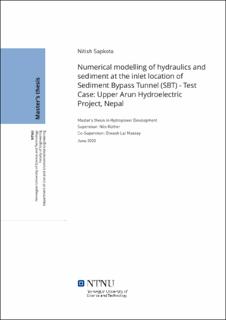| dc.description.abstract | The study aims to analyse the effects of sediment bypass tunnel inlet location on intake hydraulics and suspended sediment removal for a reservoir of Upper Arun Hydroelectric Project (UAHEP) using numerical modelling program, SSIIM 2. The primary idea is to assess the suitability of numerical model for optimization study in collaboration with physical hydraulic model, thereby supporting the hybrid modelling concept.
The physical hydraulic models have limitations on scaling suspended sediments and hence, these models might not fully capture the behaviour of sediments questioning the reliability of result. Similarly, the time, energy and cost involved for various modifications in physical hydraulic model would be greater leading to exclusion of various probable possibilities. Therefore, it might be better to calibrate the numerical model using the physical hydraulic model data and study the effects of different modifications and parameters to optimize the result. For the test case, relevance of shifting sediment bypass tunnel inlet location upstream of the initial location has been studied based on various sensitive numerical parameters.
The hydraulic and sediment (suspended) simulations have been carried out for a fixed water level of 1,625masl and 877m3/s discharge converted to a model scale of 1:50, for two different sediment bypass tunnel inlet locations (i.e. initial and shifted locations). Hydraulic simulation is used to finalize the bed deposition geometry and necessary algorithms along with parameters for sediment simulation. The simulation is calibrated by comparing the surface velocities at various cross sections with physical model test results for the initial location. Similarly, suspended sediment concentration at sediment bypass tunnel (SBT) outlet has been compared with physical model test results to validate the sediment simulation. In case of shifted location, suspended sediment simulation has been carried out using previously calibrated hydraulic model, by shifting the sediment bypass tunnel inlet location further upstream. Among two inlet locations, higher suspended sediment concentration at sediment bypass tunnel outlet and higher reservoir trapping have been observed for shifted inlet location. Similarly, smoother flows with increased erosion, upstream of the sediment bypass tunnel have been observed in shifted location. Thus, better results for shifted inlet location signifies it being more relevant for suspended sediment handling than the initial one. Further, the effect of various parameter like roughness height (ks), sediment transport formula etc have also been analysed which would rather be difficult in physical hydraulic model. The conformance of the numerical model’s surface velocities and sediment concentration at SBT outlet with physical model signifies, the ability of numerical model to replicate the physical model, thereby providing fore grounds for further analysis and hybrid modelling.
Good quality and large number of measurement data are required for properly replicating physical model into numerical model. The unavailability of required number of bed deposition data in this study, might have affected the accuracy of results. Also, simulation have been carried out for only one operating condition. So, different operating conditions have to be checked before finalising the sediment bypass tunnel inlet location. Similarly, limitations of the program, SSIIM 2, like inability to use different density materials, roughness values etc leads to uncertainty in results. Therefore, further work to minimize above discrepancies and result verification with the final physical model tests are recommended. | |
